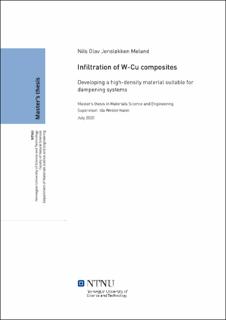| dc.contributor.advisor | Westermann, Ida | |
| dc.contributor.advisor | Jensen, Tormod | |
| dc.contributor.advisor | Ottesen, Einar Leo | |
| dc.contributor.author | Meland, Nils Olav Jensløkken | |
| dc.date.accessioned | 2021-09-28T18:15:35Z | |
| dc.date.available | 2021-09-28T18:15:35Z | |
| dc.date.issued | 2020 | |
| dc.identifier | no.ntnu:inspera:59547306:15939390 | |
| dc.identifier.uri | https://hdl.handle.net/11250/2785299 | |
| dc.description.abstract | Formålet med denne masteroppgaven er å diskutere om det infiltrerte W-Cu produktet er en levedyktig erstatning for en dempermassekomponent for bruk i dempesystemer. De mekaniske egenskapene ble testet ved bruk av strekkprøving og var sammen med forskjellige mikroskopiteknikker brukt for å gi en oversikt over komposittens ytelse sammenlignet med materialspesifikasjoner gitt for applikasjonen.
Sandvik Teeness utvikler og produserer vibrasjonsdempende verktøy som brukes til drei- og fres operasjoner. Disse verktøyene er spesialiserte for prosesser der det er nødvendig å maskinere over lange overheng. I disse tilfellene oppstår vibrasjonsproblemer. Dempesystemet i disse verktøyene absorberer vibrasjonene, for å sikre at bearbeidingsprosessene gir fine overflater.
Komponenter som brukes i dempesystemer er laget av et materiale med høy tetthet. Materialer basert på bly må byttes ut på grunn av miljøhensyn. En erstatning som for tiden er i bruk, er basert på en wolframlegering laget ved en sintringsprosess. Prosessen gir produkter av høy kvalitet, men er dyre å produsere. Derfor foreslås et alternativt materiale.
Tre forskjellige prøver, hvor to av prøvene var W-Cu-Sn-kompositter, mens den siste prøven er en W-Cu-Ni-kompositt, ble undersøkt i denne masteroppgaven. Prøvene ble testet og sammenlignet med materialspesifikasjonene for applikasjonen. W-Cu-Ni-prøven viste den største elastisitetsmodulen med 98,12 GPa, en stor flytespenning på 309,83 MPa og den største totale forlengelsen med 2,61% av prøvene. Elastisitetsmodul og den totale forlengelsen på prøvene nådde ikke de gitte kriteriene, mens flytespenningskriteriet ble oppnådd av alle tre.
Konklusjonen er at W-Cu kompositter viser et godt potensial til bruk som materialet for den gitte komponenten for dempesystemer. Noen endringer i sammensetning er nødvendig for å oppfylle alle kravene i tillegg til forbedring tilknyttet infiltrasjonsprosessen, men prosjektet er på rett vei mot å oppnå målsetningen. Materialet oppfyller miljøhensynene og har potensial til å være en levedyktig erstatning for materialet brukt til dempermasse i dempesystemer. | |
| dc.description.abstract | The aim of this thesis is to discuss whether the infiltrated product of W-Cu is a viable substitute for a damper mass component for the use in dampening systems. The mechanical properties were tested using tensile testing and were together with different microscopy techniques used to give an overview of the composite's performance compared with material specifications given for the application.
Sandvik Teeness develops and produces vibration dampening tools used for subtractive manufacturing. These tools are specialized for processes where it is necessary to machine over long overhangs. In these cases, vibration problems occur. The dampening system in these tools absorbs the vibrations, to ensure the machining processes yields clean surfaces.
Components used in dampening systems are made from a material of high density. Lead based materials need to be replaced due to environmental considerations. A substitute currently in use is based on a tungsten alloy made from a sintering process. The process yields high quality products but are expensive to produce. Therefore, an alternative material is proposed.
Three different samples, with two of the sample being W-Cu-Sn composites while the last sample is a W-Cu-Ni composite, were examined in this thesis. The samples were tested and compared with the material specification for the application. The W-Cu-Ni sample showed the largest elastic modulus 98.12 GPa, a large yield strength of 309.83 MPa and the largest total elongation 2.61% of the samples. The elastic modulus and total elongation criteria were not fulfilled for any of the samples, while the yield strength criterion was attained by all of them.
The conclusion is that W-Cu composites show good potential to be used for the given component for dampening systems. Some alterations to the material composition are needed to fulfil all the requirements along with improved infiltration, but the project is on the right path towards accomplishing the aim. The material fulfils the environmental considerations, and have the potential to be a viable substitute for the material for damper mass used in dampening systems. | |
| dc.language | | |
| dc.publisher | NTNU | |
| dc.title | Infiltration of W-Cu composites - developing a high-density material suitable for dampening systems | |
| dc.type | Master thesis | |
